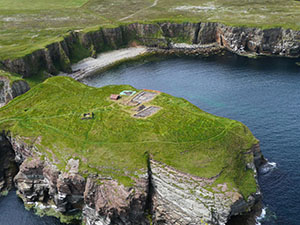The Brough of Deerness and the Viking Age Diaspora
By James Barrett, James Gerrard and Adam Slater

The Brough of Deerness under excavation in 2008 (V. Herring)
The Brough of Deerness is a well-preserved Viking Age settlement set atop a c. 30 m high sea stack in Orkney's east Mainland, Scotland. The summit of the stack is crowned by the ruins of a c. tenth- to twelfth-century chapel and the earthworks of approximately 30 associated buildings. The chapel was excavated in the 1970s, when it was found to have a timber phase that preceded the extant stone building, with a coin of Eadgar (AD 959–975) stratified between the two. This chapel is thus among the earliest known evidence for Viking Age Christianity in the Scandinavian North Atlantic region. The site is a Scheduled Ancient Monument and forms part of a much-visited nature reserve owned and managed by the Orkney Islands Council.
Although unique in many respects, the site belongs to a group of early historic islet, promontory and stack settlements known from coastal Scotland and the Irish Sea province. These sites have the potential to offer important clues regarding the relationship between political organization, religion and mobility. This is so whether they were centres of lordship as at Birsay in Orkney and St Patrick's Isle in Man, monastic communities like Iona and the Isle of May, or smaller sites (e.g. hermitages) that formed part of the settlement hierarchy within either of these broad (and potentially overlapping) cultural and functional categories. In any of these eventualities they potentially materialize elements of power, belief and long-range interconnections.

Topographic model showing earthworks of Viking Age houses (M. Saunders)
In 2008 and 2009 the McDonald Institute for Archaeological Research, in collaboration with partners including Orkney College and the Friends of St Ninian's (a local charity), began a project to investigate the settlement associated with the chapel. Three Viking Age houses have been investigated thus far, and found to be dug into earlier ('Pictish') layers of approximately sixth- to ninth-century date.
It now seems clear that the main Viking Age phase of settlement should be interpreted as a chiefly stronghold, rather than an ecclesiastical centre or a temporary refuge for example. The justifications for this interpretation include evidence for long-lived domestic settlement, the small number of burials (including infants), some objects implying at least aspirations to high status, the defensive location, a hierarchical organization of space within the settlement and the lack of ecclesiastical sculpture. However, the excavations are also demonstrating that the site's function changed through time so the story may ultimately prove to be more complex. Understanding these temporal trends and their wider implications (in terms of social, political and ecclesiastical change in Scotland, the North Atlantic and Europe) remains the most critical goal of further excavation at the site.
Our preliminary results are outlined in two annual reports which can be downloaded here, and are being incorporated into new displays in the Visitor Centre at the Mull Head Nature Reserve.
The Brough of Deerness Excavations 2008: Annual Data Structure Report (pdf 9mb)
The Brough of Deerness Excavations 2009: Annual Data Structure Report (pdf 4.9mb)
The work is on-going. Past and present financial support has been kindly provided by the Isaac Newton Trust, the Higher Education Innovation Fund, the McDonald Institute for Archaeological Research, the Orkney Islands Council, the Russell Trust, the Society of Antiquaries of Scotland, the Society of Antiquaries of London, the Royal Norwegian Embassy (London), the Royal Norwegian Consulate General (Edinburgh) and the Andrew W. Mellon Foundation as part of the 'Crisis, What Crisis?' project. Assistance in kind has been provided by Historic Scotland, Orkney College, the Orkney Museum and Julie Gibson, the Orkney Islands Archaeologist.



